EU-155: NEVERLAND
The RSGB IOTA award is a serious one, nothing short of an adrenaline rush to ham operators around the world. It’s the passion of the hunt for new entities and the commitment of the prefix providers to transmit their signals from the most famous and remote islands of the world; and why not…do a little research to find new and never activated ones.
This award is likely the only one in a position to compete with DXCC for authority and popularity. It’s precisely for these reasons that the story I’m about to tell you is amazing. We’re talking about an island which isn’t, or rather, it has an IOTA reference, but in reality doesn’t exist. We’re talking about EU-155, the reference making up of the islands of Scanno di Piallazza and Baron.
Background
So, let’s first talk a little about the background. Wanting to participate in the IOTA Contest from EU-155 I went on-site for a look around. Having barely met the boatman who was to ferry me across to the island, I was asked exactly where I wanted to go, bacause according to him “there were years that the island - that is to say, the sandbar – no longer existed and for at least 15 of those years Baron Island was no longer.
At that moment it was like a slap in the face, but I didn’t let that stop me, having decided to take a good look around, just to make sure that the boat captain wasn’t mistaken.
That which follows lists the evidence of which I’m aware, having forwarded the same in a timely manner for the edification of the IOTA Committee of the RSGB.
Sacca di Goro
Before embarking on this journey, it is well to survey the geographical area of which we speak. We find ourselves located in the central meridian of the Po delta (old Adriatic), in the Province of Ferrara, more precisely in “Sacca di Goro.” This is one of the the largest saltwater lagoons of the Northern Adriatic, with an average depth of 60cm and receives freshwater from Po di Goro, Po di Volano and from other smaller canals, along with saltwater from the seafront. In this typical delta-type lagoon an abundance of shellfish thrives as a result. Although it’s an area protected by numerous measures, this remains the reason it maintains such a strong human presence. In fact, as a means of improving production, allowing for a greater flow of oxygen rich water, the area has been the subject of numerous actions deriving from the strategic sinking of several wrecked or decommisioned boats leading up to the removal of sand by means of a dredger.
The birth of EU-155
I could be mistaken, but according to my research, it seems that talk of Scanno di Piallazza referring to IOTA goes back to the year 1994. Perhaps taking its cue from a map similar to that which you see below.
A.D. 1988
But observing a map from 1988 you’ll note that six years before the situation was not the same. The Scanno di Piallazza was just the most extreme part of “Scannone Goro”, a long sandbar, taking elongated form some 10km to the west. What must have changed the profile of the Scannone Goro morphologically is rather easy to discover. In order to increase the inflow of water rich oxygen inside the lagoon, a small canal was opened into the heart of the “Scannone Goro”.
This “operation” unfortunately, ended up triggering a disruptive phenomenon of erosion towards the West causing it to lose the most on a day to day basis from Scannone Goro, until it became an entity unto itself, called the Scanno di Piallazza.
The erosive Phenomenon
The erosion, thus caused by mankind, meant that there really existed an island named Scanno di Piallazza. That this be considered manmade is less important. The fact is that without the manmade canals (or channels), nothing could have ever formed. It’s too bad that when triggering the phenomenon, it could not have been stopped, leading to, in the shortest of time, the disappearance of the whole island.
Here’s a series of rather eloquent photographs which witness to the evolution of that part of the coast over the years.
A.D. 1994
A.D. 2000
A.D. 2006
A.D. 2006 – Detail
Quickbird satellite – Sept. 2005 vs. Dec. 2006
The evidence of human intervention is evident. There are various documents to be found on the internet which indicate that 65,000 cubic meters of sand were deposited in an attempt to stop the erosion, right in the area of Scanno di Piallazza, where it’s easy to be able to take pictures of the dredging operations underway.
A question arises
Looking at these pictures we are confronted with images which truly speak for themselves: with the island having not existed for several years now, where have the various teams transmitted from who’ve had the distinction of activating EU-155 in recent years? Basically from two places:
From the Gorino lighthouse
From the far end of Scannone Goro.
The Gorino Lighthouse is an ideal place:
Electricity, saltwater just 10 meters away ready to accomodate radials at your discretion, clean toilets, warm beds and you can eat inside the restaurant located inside the top part of the lighthouse itself. The only problem is that the Gorino Lighthouse isn’t located on Scanno di Piallazza, but rather on Scannone di Goro. Unfortunately, these names don’t indicate the same sandbar. The Italisan Island Award comes under review using various references. Among other things, Scannone di Goro is connected to firm ground by a series of quite small bridges just a few meters in length.
Many expeditions have found here the ideal QTH, leaving diverse hints of their passage on the web.
While these activities may presuppose a fleeting knowledge of the area, and when all is said, a measure of good faith, the same can not be said of that which has transpired on the western extremity of Scannone di Goro.
Unfortunately, relating to these activities, nobody has been successful in coming up with any photographs, neither on-line nor from those who took them, to such a degree as to demonstrate the exact position of the island. All assure that they were on Scanno di Piallazza, even though it didn’t exist during this period of time…
The End of Baron Island
But some might argue that EU-155 consists of two islands, Scanno di Piallazza and the Island of Baron. For researchers in the area and the local fishermen’s cooperative, “Baron” is just the name of one of the many areas of cultivation and fishing. It’s likely that at the beginning of this phenomenon of erosion, that a part of the Piallazza was separated from the main body. Concerning this, however, i have never been able to find evidence in the photos and in the documentation which I was able to view.
La Sacca di Goro, today
Today’s image of the area is the most up to date on Google. You can see a strange little island emerge where at one time the Scanno di Piallazza was present. It’s the island of Fratcelli, an artificially created island constructed to facilitate the mating and nesting of a species of birds whose survival was threatened by the disappearance of their very habitat due to erosion.
Island of Fraticelli on Google
What does the RSGB IOTA have to say about it?
We are sure, IOTA cannot know everything about the 1200 references in the world. But an unclear situation has a way of disincentivizing supporters of the IOTA program and in general, those who would like to activate a reference, who, however, occasionally feel torn between their desire to respect the rules and their yearning to activate a somewhat rare reference. So we hope that the RSGB IOTA can quickly clarify the situation with regard to EU-155, for a game with transparent rules is undoubtedly nicer and more fun for everyone. In the meantime we will not stop to look for the island that isn’t, with the hope that it may be found someday.
Read more...
Monday, October 31, 2011
Saturday, October 22, 2011
Propagation Updated
Our Sun continues to be very active, with most days revealing more
sunspots. We saw one new sunspot group on October 9, another on
October 10, then two more on October 11 and two more on October 12.
Then another on October 13, two more on October 15, two more on
October 17, one more on October 19 and three more on October 20.
There have been 28 new sunspot groups making an appearance in the
last 30 days.
But the biggest news is the sunspot number yesterday, Thursday,
October 20. The daily sunspot number was 195, a level not equaled
or bettered since nearly eight years ago, on November 26, 2003, when
it was 209. The closest the daily sunspot number came to equaling
Thursday's value was on July 4, 2005 when it was 192.
Average daily sunspot number rose over 66% this week, or 63.2 points
(October 13-19) over last, to 158.6, and average daily solar flux
for the same period rose over 15% (or 19.1 points) to 144.2. With
the geomagnetic indices this week below the previous week, radio
amateurs have frequently been working stations on other continents
as late as midnight on ten meters. The bands are alive.
The latest forecast from USAF/NOAA shows solar flux at 160 from
October 21-22, 155 and 150 on October 23-24, 145 on October 25-27,
135 on October 28, then 130 on October 29 through November 3. Note
that for the next few days, this represents a substantial increase
over what was reported one day ago in the ARRL Letter. That was
based on Wednesday's prediction, which showed 145 on October 20,
when the actual value turned out to be 159.1.
Planetary A index is predicted at 5 on October 21-27, 8 on October
28-30 and 5 on October 31 through November 2, and 8 on November 3-5.
Geophysical Institute Prague shows quiet conditions October 21-13,
quiet to unsettled October 24, and quiet again October 25-27.
Mike Shaffer, KA3JAW in Tampa, Florida (EL87) reported his
observations of the Draconid meteor shower on October 8, 2011
between 1600-2100 UTC. He said there is no chance of seeing the
shower in North America because of a waxing gibbous moon.
Mike decided to use signals from Cuban analog television on channel
2, seeing if he could detect reflections off the meteor trails. At
1732 UTC he noticed elevated signal to noise ratio on the video
carrier frequency, 55.25 MHz. At 1900 UTC 2 meter meteor scatter was
occurring over Central Europe, with propagation from the UK to
Russia. The rate peaked at 2010 UTC, with stations from Sweden to
Israel joining in.
Mike wrote, "Meteor scatter signals were observed at the following
times: 1847, 1857, 1909 and 2000 UTC with a bright white video
raster scan flash observed on the TV screen and/or audio tics,
whistles, pings lasting anywhere between a quarter to one second in
duration.
"You don't need professional grade equipment to achieve results. In
my case it was done with a minimum amount of hardware, a pre-1995
13-inch color television set that does not have video mute circuits
(blue screen when no signal is present) with 25 feet of RG-6
low-loss satellite coax cable coupled to a non-amplified low-VHF
'cut-to-band' outdoor television antenna that is mounted 10 feet off
the ground.
"If you want to achieve more efficiency with increasing your meteor
detection rates, obtain a low noise, medium to high gain (10-20 dB)
antenna preamplifier placed near the antenna feed-point.
"Meteor scatter signals can be heard roughly from 300 to 1,000 km
distance."
Thanks, Mike!
Jon Jones, N0JK reported a peak rate of 660 meteors per hour
centered on 2010 UTC October 8. He was QRV in EM28 on both 6 and 2
meters. Nothing heard on 2 meters, but he did see action on 6 meters
on 50.125 MHz.
Jon writes, "I worked W6OAL DM79 at 1958 UTC and K7TNT DN74 at 2013
UTC, both random on SSB.
"W6OAL was quite loud, K7TNT peaked to 5x9 but mostly not as strong.
He was in almost all the time on residuals, heard him work K0MVJ
EN35 MN and K9ZM EN50. The meteors seemed to peak between 1945-2030
UTC.
"A sharp drop off after 2030 UTC, but interesting meteor scatter
conditions in the middle of the afternoon. The Draconids are a
'slow' shower as the meteors strike the ionosphere at 20 km/sec vs.
60 km/sec for the Perseids. Thus the ionization per meteor would be
lower. The peak time of visual observed meteors in Europe correlated
with radio reflections on 50 MHz."
Pat Dyer, WA5IYX of San Antonio, Texas reported on October 13:
"While the N-S 6m paths to South America from here continue to
improve as the cycle advances, the recent FK8CP (New Caledonia)
paths have come as a pleasant surprise here.
"The best so far was 2330z Oct 09 - 0020z Oct 10 where FK8CP reached
as high as a true S7 on the meter. The US footprint was initially
limited to Central and East Texas along a narrow-latitude belt (it
did eventually extend as far east as the New Orleans area). This is
in keeping with the F2F2 mode involving a critical set of angles in
the geometry. Later that evening (US time) FK8CP was reported from
a wider range of states, NM, CO, et al. (My last 6m FK QSOs were in
Cycle 22 back in 1989 and 1991.)
"24 hours later his signals here were fleeting, but he was worked in
Western and West Central Florida. Again, the US footprint was only
about 2-deg wide in N-S latitude extent (though the Gulf of Mexico
may have well obscured a wider range there).
"As can be seen from Sherlock DX map plots, Florida is the favored
US QTH for these daily 6 meter South American paths. The paths
often spread across to Mexico (to within 600-700 mi south of here),
often making one wish for an Es-linking event!
"The 47-48 MHz Chilean FM broadcast signals
(http://www.qsl.net/ce3sad/6m.html) provide excellent high-power MUF
indicators for that region, but they will often show just how
sluggish things can be to move up the next 2-MHz into 6 meters
proper! These are relatively-high ERP signals with probably good
transmitter locations vs. the other 2-way land-mobile signals in
many regions down there that used to serve as propagation clues
(they are also 24/7!)
"From here the best crossing angles of the geomagnetic equator have
their land endpoints in the CE0 islands. For over four decades now
many have seen a strong need for some reliable 6 meter beacon(s) to
be established down there to confirm our suspicions of just how good
those paths are. The few well-equipped and dedicated 6 meter
expeditions to those areas at the best time(s) of the year (and
Cycle) HAVE been very productive."
On October 14 we received this report from Ted Saba, KN5O of
Covington, Louisiana: "I worked Remi, FK8CP, on 6M on 10/9/2011 at
2341z on SSB with 5/1 signals both directions and on CW at 2346z
with 5/1-2/9 signals both directions. I'm located in EM40xl. This
was my longest DX QSO since working Japan. I was hoping to snag
Fred, KH7Y, to complete my 6M WAS that same evening, but the
propagation never made it as far east as my QTH.
"Shortly after working Remi, I called my friend Dallas Ward, K1DW,
and he was also able to work him on CW. K1DW is also located in
EM40."
Steve Moles, N5MX of Pawhuska, Oklahoma wrote: "I was able to work
FR/DJ7RJ (Willi) on 15 October 2011 at approximately 1832 UTC on 15m
SSB. It was my first FR contact. Today (16 October 2011) I heard and
worked FR4NT (Cyril, on Reunion Island) on 10m SSB at approximately
1625 UTC. I had Cyril 59 into my home in northern OK and he had me
59 into Reunion. Both QSOs are approximately 10421 miles (16771 km)
from my home. What a difference a few sunspots make! I remember not
too long ago having a SFI in the low 60s, today is only 138, but it
makes so much difference. It is so nice to hear the upper bands open
consistently."
Thanks, Steve for sharing the excitement!
Peter Dougherty, W2IRT of West Caldwell, New Jersey wrote on October
18: "With today's SFI of 153, low Ap/Kp numbers and an SSN of 165 I
naturally expected 10 to be decent but I was not expecting this:
I've been chasing new WAZ Zones on 10 since things started to take
off last month but all the prediction software and even N6BT's own
awesomely-detailed charts in the ARRL Antenna Book were saying Zone
18 to Zone 5 on 10m just wasn't in the cards until the Flux hit
'very high' levels, i.e. over 200. Just after noon local (1600z)
UA0BA from Norilsk was a solid S9 into New Jersey. This is more than
six hours after his sunset at 69 degrees north latitude! I continued
to listen and even an hour and a half later he'd built up to S9+10dB
peaking 20-over (albeit with more arctic flutter). Just a few
minutes later RI1FJA from Franz Josef Land was blasting through on
10m SSB, also peaking over S9."
Thanks, Peter. That's fantastic. We are also seeing 10 meters open
here worldwide on the West Coast as late as midnight!
Sylvain Faust, VE2FET of Sainte Anne Des Lacs, Quebec wrote: "I only
had a few countries on 10M before Saturday. After 3 to 4 hours on
Saturday and an hour or 2 on Sunday, as you can see on the top of
the page (DXCC per Band) I now have 109 countries on 10M! Amazing!"
That is remarkable. He also sent a link to his logs, at
http://www.ve2fet.com/logbook.aspx, and there is a photo gallery at
http://www.ve2fet.com/gallery1/index.htm. You really should see him
at age 13 (in 1978) on television at
http://www.youtube.com/watch?v=YIq44Z2JpxA. Good chance to practice
Le Francais Quebecois.
Randy Crews, W7TJ of Spokane, Washington has achieved a state of
radio bliss: "The time we have all been waiting for has arrived.
Solar activity has advanced to the point where the high bands have
really come alive, Solid propagation on 15M throughout the day, and
world wide openings on 10 and 12 Meters - conditions not seen since
2003. Barring a major storm, the CQWW contest later this month
should be hot, in addition to the ARRL 10M contest in December. The
real 'breakout' occurred mid February of this year as the Sunspot
Count and Solar Flux clearly exceeded its 2 1/2 year doldrums lows
and ushered in what we are seeing today. It has been a long, long
dry spell for the higher bands, now 10 and 12 Meter DX Spots
dominate the Packet Clusters. There will be other dividends of the
higher solar activity: Long Path Propagation on 20M will be a
regular occurrence along with increased night time propagation on
40/30 and 80 Meters as the F layers residual ionization holds thru
the night and into the morning gray line. Good times especially for
us in the Northern Hemisphere, and for all."
Jeff, N8II wrote: "12 and 10M conditions have been outstanding most
days with JT logged on 12M around 24Z, BA/BD logged on both 12 and
10 from 23-0030Z. I had a drone of EU signals calling thanks to a
cluster spot on 10M around 1500Z on October 17, the loudest were
S9+20dB. I also had a run of mostly UA3/RA3 area stations on 10M
Friday the 14th that lasted from 1315-1400Z including a call from
UN7; there were still loud Russians from around Moscow on 10 M past
15Z. Also, I was called by E21EJC in Thailand on 12M CW while
working 4L1MA around 1320Z on the 17th. VU2GSM was loud on 10M SSB
at around 1445Z on the 16th. We have reached the point where good EU
openings occur almost daily on 10 and JAs are loud as well about 70%
of the time, some JAs S9+20dB, extremely loud for this area."
Check this article on sunspot observations by Samuel Heinrich
Schwabe at,
http://arxiv.org/PS_cache/arxiv/pdf/1110/1110.3620v1.pdf.
If you would like to make a comment or have a tip for our readers,
email the author at, k7ra@arrl.net.
For more information concerning radio propagation, see the ARRL
Technical Information Service web page at
http://arrl.org/propagation-of-rf-signals. For an explanation of the
numbers used in this bulletin, see
http://arrl.org/the-sun-the-earth-the-ionosphere. An archive of past
propagation bulletins is at
http://arrl.org/w1aw-bulletins-archive-propagation. Find more good
information and tutorials on propagation at
http://myplace.frontier.com/~k9la/.
Monthly propagation charts between four USA regions and twelve
overseas locations are at http://arrl.org/propagation.
Instructions for starting or ending email distribution of ARRL
bulletins are at http://arrl.org/bulletins.
Sunspot numbers for October 13 through 19 were 147, 157, 166, 158,
165, 155, and 162, with a mean of 158.6. 10.7 cm flux was 137.6,
136.1, 137.7, 151, 152.6, 146.8, and 147.3, with a mean of 144.2.
Estimated planetary A indices were 5, 2, 8, 7, 4, 5, and 7, with a
mean of 5.4. Estimated mid-latitude A indices were 3, 1, 4, 7, 2, 5,
and 5 with a mean of 3.9.
Read more...
sunspots. We saw one new sunspot group on October 9, another on
October 10, then two more on October 11 and two more on October 12.
Then another on October 13, two more on October 15, two more on
October 17, one more on October 19 and three more on October 20.
There have been 28 new sunspot groups making an appearance in the
last 30 days.
But the biggest news is the sunspot number yesterday, Thursday,
October 20. The daily sunspot number was 195, a level not equaled
or bettered since nearly eight years ago, on November 26, 2003, when
it was 209. The closest the daily sunspot number came to equaling
Thursday's value was on July 4, 2005 when it was 192.
Average daily sunspot number rose over 66% this week, or 63.2 points
(October 13-19) over last, to 158.6, and average daily solar flux
for the same period rose over 15% (or 19.1 points) to 144.2. With
the geomagnetic indices this week below the previous week, radio
amateurs have frequently been working stations on other continents
as late as midnight on ten meters. The bands are alive.
The latest forecast from USAF/NOAA shows solar flux at 160 from
October 21-22, 155 and 150 on October 23-24, 145 on October 25-27,
135 on October 28, then 130 on October 29 through November 3. Note
that for the next few days, this represents a substantial increase
over what was reported one day ago in the ARRL Letter. That was
based on Wednesday's prediction, which showed 145 on October 20,
when the actual value turned out to be 159.1.
Planetary A index is predicted at 5 on October 21-27, 8 on October
28-30 and 5 on October 31 through November 2, and 8 on November 3-5.
Geophysical Institute Prague shows quiet conditions October 21-13,
quiet to unsettled October 24, and quiet again October 25-27.
Mike Shaffer, KA3JAW in Tampa, Florida (EL87) reported his
observations of the Draconid meteor shower on October 8, 2011
between 1600-2100 UTC. He said there is no chance of seeing the
shower in North America because of a waxing gibbous moon.
Mike decided to use signals from Cuban analog television on channel
2, seeing if he could detect reflections off the meteor trails. At
1732 UTC he noticed elevated signal to noise ratio on the video
carrier frequency, 55.25 MHz. At 1900 UTC 2 meter meteor scatter was
occurring over Central Europe, with propagation from the UK to
Russia. The rate peaked at 2010 UTC, with stations from Sweden to
Israel joining in.
Mike wrote, "Meteor scatter signals were observed at the following
times: 1847, 1857, 1909 and 2000 UTC with a bright white video
raster scan flash observed on the TV screen and/or audio tics,
whistles, pings lasting anywhere between a quarter to one second in
duration.
"You don't need professional grade equipment to achieve results. In
my case it was done with a minimum amount of hardware, a pre-1995
13-inch color television set that does not have video mute circuits
(blue screen when no signal is present) with 25 feet of RG-6
low-loss satellite coax cable coupled to a non-amplified low-VHF
'cut-to-band' outdoor television antenna that is mounted 10 feet off
the ground.
"If you want to achieve more efficiency with increasing your meteor
detection rates, obtain a low noise, medium to high gain (10-20 dB)
antenna preamplifier placed near the antenna feed-point.
"Meteor scatter signals can be heard roughly from 300 to 1,000 km
distance."
Thanks, Mike!
Jon Jones, N0JK reported a peak rate of 660 meteors per hour
centered on 2010 UTC October 8. He was QRV in EM28 on both 6 and 2
meters. Nothing heard on 2 meters, but he did see action on 6 meters
on 50.125 MHz.
Jon writes, "I worked W6OAL DM79 at 1958 UTC and K7TNT DN74 at 2013
UTC, both random on SSB.
"W6OAL was quite loud, K7TNT peaked to 5x9 but mostly not as strong.
He was in almost all the time on residuals, heard him work K0MVJ
EN35 MN and K9ZM EN50. The meteors seemed to peak between 1945-2030
UTC.
"A sharp drop off after 2030 UTC, but interesting meteor scatter
conditions in the middle of the afternoon. The Draconids are a
'slow' shower as the meteors strike the ionosphere at 20 km/sec vs.
60 km/sec for the Perseids. Thus the ionization per meteor would be
lower. The peak time of visual observed meteors in Europe correlated
with radio reflections on 50 MHz."
Pat Dyer, WA5IYX of San Antonio, Texas reported on October 13:
"While the N-S 6m paths to South America from here continue to
improve as the cycle advances, the recent FK8CP (New Caledonia)
paths have come as a pleasant surprise here.
"The best so far was 2330z Oct 09 - 0020z Oct 10 where FK8CP reached
as high as a true S7 on the meter. The US footprint was initially
limited to Central and East Texas along a narrow-latitude belt (it
did eventually extend as far east as the New Orleans area). This is
in keeping with the F2F2 mode involving a critical set of angles in
the geometry. Later that evening (US time) FK8CP was reported from
a wider range of states, NM, CO, et al. (My last 6m FK QSOs were in
Cycle 22 back in 1989 and 1991.)
"24 hours later his signals here were fleeting, but he was worked in
Western and West Central Florida. Again, the US footprint was only
about 2-deg wide in N-S latitude extent (though the Gulf of Mexico
may have well obscured a wider range there).
"As can be seen from Sherlock DX map plots, Florida is the favored
US QTH for these daily 6 meter South American paths. The paths
often spread across to Mexico (to within 600-700 mi south of here),
often making one wish for an Es-linking event!
"The 47-48 MHz Chilean FM broadcast signals
(http://www.qsl.net/ce3sad/6m.html) provide excellent high-power MUF
indicators for that region, but they will often show just how
sluggish things can be to move up the next 2-MHz into 6 meters
proper! These are relatively-high ERP signals with probably good
transmitter locations vs. the other 2-way land-mobile signals in
many regions down there that used to serve as propagation clues
(they are also 24/7!)
"From here the best crossing angles of the geomagnetic equator have
their land endpoints in the CE0 islands. For over four decades now
many have seen a strong need for some reliable 6 meter beacon(s) to
be established down there to confirm our suspicions of just how good
those paths are. The few well-equipped and dedicated 6 meter
expeditions to those areas at the best time(s) of the year (and
Cycle) HAVE been very productive."
On October 14 we received this report from Ted Saba, KN5O of
Covington, Louisiana: "I worked Remi, FK8CP, on 6M on 10/9/2011 at
2341z on SSB with 5/1 signals both directions and on CW at 2346z
with 5/1-2/9 signals both directions. I'm located in EM40xl. This
was my longest DX QSO since working Japan. I was hoping to snag
Fred, KH7Y, to complete my 6M WAS that same evening, but the
propagation never made it as far east as my QTH.
"Shortly after working Remi, I called my friend Dallas Ward, K1DW,
and he was also able to work him on CW. K1DW is also located in
EM40."
Steve Moles, N5MX of Pawhuska, Oklahoma wrote: "I was able to work
FR/DJ7RJ (Willi) on 15 October 2011 at approximately 1832 UTC on 15m
SSB. It was my first FR contact. Today (16 October 2011) I heard and
worked FR4NT (Cyril, on Reunion Island) on 10m SSB at approximately
1625 UTC. I had Cyril 59 into my home in northern OK and he had me
59 into Reunion. Both QSOs are approximately 10421 miles (16771 km)
from my home. What a difference a few sunspots make! I remember not
too long ago having a SFI in the low 60s, today is only 138, but it
makes so much difference. It is so nice to hear the upper bands open
consistently."
Thanks, Steve for sharing the excitement!
Peter Dougherty, W2IRT of West Caldwell, New Jersey wrote on October
18: "With today's SFI of 153, low Ap/Kp numbers and an SSN of 165 I
naturally expected 10 to be decent but I was not expecting this:
I've been chasing new WAZ Zones on 10 since things started to take
off last month but all the prediction software and even N6BT's own
awesomely-detailed charts in the ARRL Antenna Book were saying Zone
18 to Zone 5 on 10m just wasn't in the cards until the Flux hit
'very high' levels, i.e. over 200. Just after noon local (1600z)
UA0BA from Norilsk was a solid S9 into New Jersey. This is more than
six hours after his sunset at 69 degrees north latitude! I continued
to listen and even an hour and a half later he'd built up to S9+10dB
peaking 20-over (albeit with more arctic flutter). Just a few
minutes later RI1FJA from Franz Josef Land was blasting through on
10m SSB, also peaking over S9."
Thanks, Peter. That's fantastic. We are also seeing 10 meters open
here worldwide on the West Coast as late as midnight!
Sylvain Faust, VE2FET of Sainte Anne Des Lacs, Quebec wrote: "I only
had a few countries on 10M before Saturday. After 3 to 4 hours on
Saturday and an hour or 2 on Sunday, as you can see on the top of
the page (DXCC per Band) I now have 109 countries on 10M! Amazing!"
That is remarkable. He also sent a link to his logs, at
http://www.ve2fet.com/logbook.aspx, and there is a photo gallery at
http://www.ve2fet.com/gallery1/index.htm. You really should see him
at age 13 (in 1978) on television at
http://www.youtube.com/watch?v=YIq44Z2JpxA. Good chance to practice
Le Francais Quebecois.
Randy Crews, W7TJ of Spokane, Washington has achieved a state of
radio bliss: "The time we have all been waiting for has arrived.
Solar activity has advanced to the point where the high bands have
really come alive, Solid propagation on 15M throughout the day, and
world wide openings on 10 and 12 Meters - conditions not seen since
2003. Barring a major storm, the CQWW contest later this month
should be hot, in addition to the ARRL 10M contest in December. The
real 'breakout' occurred mid February of this year as the Sunspot
Count and Solar Flux clearly exceeded its 2 1/2 year doldrums lows
and ushered in what we are seeing today. It has been a long, long
dry spell for the higher bands, now 10 and 12 Meter DX Spots
dominate the Packet Clusters. There will be other dividends of the
higher solar activity: Long Path Propagation on 20M will be a
regular occurrence along with increased night time propagation on
40/30 and 80 Meters as the F layers residual ionization holds thru
the night and into the morning gray line. Good times especially for
us in the Northern Hemisphere, and for all."
Jeff, N8II wrote: "12 and 10M conditions have been outstanding most
days with JT logged on 12M around 24Z, BA/BD logged on both 12 and
10 from 23-0030Z. I had a drone of EU signals calling thanks to a
cluster spot on 10M around 1500Z on October 17, the loudest were
S9+20dB. I also had a run of mostly UA3/RA3 area stations on 10M
Friday the 14th that lasted from 1315-1400Z including a call from
UN7; there were still loud Russians from around Moscow on 10 M past
15Z. Also, I was called by E21EJC in Thailand on 12M CW while
working 4L1MA around 1320Z on the 17th. VU2GSM was loud on 10M SSB
at around 1445Z on the 16th. We have reached the point where good EU
openings occur almost daily on 10 and JAs are loud as well about 70%
of the time, some JAs S9+20dB, extremely loud for this area."
Check this article on sunspot observations by Samuel Heinrich
Schwabe at,
http://arxiv.org/PS_cache/arxiv/pdf/1110/1110.3620v1.pdf.
If you would like to make a comment or have a tip for our readers,
email the author at, k7ra@arrl.net.
For more information concerning radio propagation, see the ARRL
Technical Information Service web page at
http://arrl.org/propagation-of-rf-signals. For an explanation of the
numbers used in this bulletin, see
http://arrl.org/the-sun-the-earth-the-ionosphere. An archive of past
propagation bulletins is at
http://arrl.org/w1aw-bulletins-archive-propagation. Find more good
information and tutorials on propagation at
http://myplace.frontier.com/~k9la/.
Monthly propagation charts between four USA regions and twelve
overseas locations are at http://arrl.org/propagation.
Instructions for starting or ending email distribution of ARRL
bulletins are at http://arrl.org/bulletins.
Sunspot numbers for October 13 through 19 were 147, 157, 166, 158,
165, 155, and 162, with a mean of 158.6. 10.7 cm flux was 137.6,
136.1, 137.7, 151, 152.6, 146.8, and 147.3, with a mean of 144.2.
Estimated planetary A indices were 5, 2, 8, 7, 4, 5, and 7, with a
mean of 5.4. Estimated mid-latitude A indices were 3, 1, 4, 7, 2, 5,
and 5 with a mean of 3.9.
Read more...
Thursday, October 20, 2011
A Remote tuned Dipole that covers ALL of 75/80 Meters without a tuner!
The RTV80
A Remote tuned Dipole that covers ALL of 75/80 Meters without a tuner!
A Remote tuned Dipole that covers ALL of 75/80 Meters without a tuner!
Now one dipole for the entire spectrum from 3.5Mhz - 4.0Mhz!
Now you can have the entire 75/80 meter band at your disposal using one dipole
without the use of a tuner!

How it works and is assembled:
without the use of a tuner!

How it works and is assembled:
HOW IT WORKS: version 1- refer to drawing above.
The wench at the bottom of the tower is used to take up or let out the Dacron rope that is routed up the tower and connected to a pair of Dacron ropes that pass through two pulleys near the apex of the antenna. Each rope is connected to the ends of the antenna wires which in turn are routed between a pair of sheaves to keep the wires close together and maintain electrical contact.
The wires continue down to the lower sheave or pulley, around and back through the upper pair and up to the feed point insulator where they are connected directly to the center and shield of the coax, the same as you would with a regular inverted V or dipole. The lower end of the take-up system is attached to Dacron ropes that pass through elevated pulleys and are then attached to counter weights.
The weights maintain tension on the wires as the wench lets it out or takes it up.
After the antenna was installed, an MFJ analyzer was used to find the lowest reflected power at regular intervals on the 80 meter band and the Dacron rope was marked with frequency tags at the wench. We can take up or let out the wench until we’re at the frequency desired.
This would be the budget version of the adjustable inverted V. You would do the frequency changes by cranking the wench handle at the base of the tower – maybe not so good on a rainy day.
If you desire to operate the antenna from within the shack, there are several methods that may be employed.
The redneck version would use pulleys to route the Dacron rope into the shack where you can directly control the wench and see the frequency tags.
A counter could also be driven from the wench although a tracking system is unnecessary if you tune to the lowest SWR at the frequency desired.
We added a 12 volt DC window motor to drive the wench and control it with a DPDT switch which takes its power from the same source that powers the radios.
You can imagine a remote control system to track the position, run the wench and limit travel, but the cost goes up. One possible solution that could be added to the 12 volt system, would be a wired or wireless camera positioned where it can see the wench and tracking system and connected to a PC or small monitor in the shack. Our prototype antenna goes from around 3.40 Megs to well about 4.4 Megs with the push of a button. We now believe the concept is sound. We believe the same system will work on 160 meters or any band where a single frequency antenna won’t cover the entire band. As always, feedback is welcome.
The wires continue down to the lower sheave or pulley, around and back through the upper pair and up to the feed point insulator where they are connected directly to the center and shield of the coax, the same as you would with a regular inverted V or dipole. The lower end of the take-up system is attached to Dacron ropes that pass through elevated pulleys and are then attached to counter weights.
The weights maintain tension on the wires as the wench lets it out or takes it up.
After the antenna was installed, an MFJ analyzer was used to find the lowest reflected power at regular intervals on the 80 meter band and the Dacron rope was marked with frequency tags at the wench. We can take up or let out the wench until we’re at the frequency desired.
This would be the budget version of the adjustable inverted V. You would do the frequency changes by cranking the wench handle at the base of the tower – maybe not so good on a rainy day.
If you desire to operate the antenna from within the shack, there are several methods that may be employed.
The redneck version would use pulleys to route the Dacron rope into the shack where you can directly control the wench and see the frequency tags.
A counter could also be driven from the wench although a tracking system is unnecessary if you tune to the lowest SWR at the frequency desired.
We added a 12 volt DC window motor to drive the wench and control it with a DPDT switch which takes its power from the same source that powers the radios.
You can imagine a remote control system to track the position, run the wench and limit travel, but the cost goes up. One possible solution that could be added to the 12 volt system, would be a wired or wireless camera positioned where it can see the wench and tracking system and connected to a PC or small monitor in the shack. Our prototype antenna goes from around 3.40 Megs to well about 4.4 Megs with the push of a button. We now believe the concept is sound. We believe the same system will work on 160 meters or any band where a single frequency antenna won’t cover the entire band. As always, feedback is welcome.
Additional notes, suggestions and comments:
The coax feed comes up between the two pieces of Plexiglas and is held in place on one side only with zip ties. The ¼ 20 SS bolts are inserted through the “bottom”. The 2 sheaves are dropped onto the bolts and the soldering is done before the “top” side is installed.
The “rules” are the same as for any inverted V. Nothing we’ve done has changed the operational characteristics of a “standard V”, as far as we can tell. What did change was the ability to find the best apex angle as it is now just a matter of tuning to any given frequency and looking at the data, then raising or lowering the antenna and comparing to fine the best center height relative to end heights.
Sam, KC4TAQ, the co-designer - lowered the tower from 55 feet (and antenna) to around 35 feet but made no changes to the end heights and found it moved the resonant frequency well down the band. All he had to do was take up on the wench (from in the shack) and it came back down to a 1 to 1 SWR. It does not appear that height is critical to this design.
We are using a DC window motor direct driving a wench spool with Dacron rope to do the adjusting. Due to the distance from the top block to the wench, the Dacron level winds perfectly onto the spool. As an alternative, you could use a small boat trailer wench or you may even find a large bait casting reel in a flea market if you want to change frequencies at the base of the tower. In this case, some means of tracking the frequency change will be needed. One option would be colored heat shrink tubing placed at proper intervals along the Dacron rope to create a visual scale.
When tuning from in the shack, we just use low power on the desired frequency and run the wench until the SWR falls to a minimum. Our objective was to design an antenna that would allow you to go to the local super center and find most of the parts you need.
As you see in the documentation, the critical thing is to keep the returning wire as close as possible to the top wire. Stiffer wire may work, but it hardens quicker than the flexible stuff but you should get several years of service even with #16 or 14 stranded copper.
The weight strips are to keep the blocks from flipping over. We didn’t want any extra metal in close proximity to the wire, hence the Plexiglas extension.
Extra weight (lead sinkers) can be added to the bottom of the Plexiglas strips if needed.
Theoretically, there should be no reason why you could not use this concept to go from 160 up to 40 meters or higher. It would require a multi-part pulley system at the turnaround block if you take up more than half of the wire in the system. A 40 meter trap may also allow for two bands. If you use a larger diameter wire from the feed point out to the trap then you should be able to cover the 40 meter band without a tuner.
The counter weights need only keep a reasonable amount of tension on the wires. We used about 12” of 3” PCV pipe with a cap on the bottom and have it about half full of steel punch outs from one of our iron workers. Sand bags would work equally well. We would like to hear from anyone that decides to build this antenna.
The coax feed comes up between the two pieces of Plexiglas and is held in place on one side only with zip ties. The ¼ 20 SS bolts are inserted through the “bottom”. The 2 sheaves are dropped onto the bolts and the soldering is done before the “top” side is installed.
The “rules” are the same as for any inverted V. Nothing we’ve done has changed the operational characteristics of a “standard V”, as far as we can tell. What did change was the ability to find the best apex angle as it is now just a matter of tuning to any given frequency and looking at the data, then raising or lowering the antenna and comparing to fine the best center height relative to end heights.
Sam, KC4TAQ, the co-designer - lowered the tower from 55 feet (and antenna) to around 35 feet but made no changes to the end heights and found it moved the resonant frequency well down the band. All he had to do was take up on the wench (from in the shack) and it came back down to a 1 to 1 SWR. It does not appear that height is critical to this design.
We are using a DC window motor direct driving a wench spool with Dacron rope to do the adjusting. Due to the distance from the top block to the wench, the Dacron level winds perfectly onto the spool. As an alternative, you could use a small boat trailer wench or you may even find a large bait casting reel in a flea market if you want to change frequencies at the base of the tower. In this case, some means of tracking the frequency change will be needed. One option would be colored heat shrink tubing placed at proper intervals along the Dacron rope to create a visual scale.
When tuning from in the shack, we just use low power on the desired frequency and run the wench until the SWR falls to a minimum. Our objective was to design an antenna that would allow you to go to the local super center and find most of the parts you need.
As you see in the documentation, the critical thing is to keep the returning wire as close as possible to the top wire. Stiffer wire may work, but it hardens quicker than the flexible stuff but you should get several years of service even with #16 or 14 stranded copper.
The weight strips are to keep the blocks from flipping over. We didn’t want any extra metal in close proximity to the wire, hence the Plexiglas extension.
Extra weight (lead sinkers) can be added to the bottom of the Plexiglas strips if needed.
Theoretically, there should be no reason why you could not use this concept to go from 160 up to 40 meters or higher. It would require a multi-part pulley system at the turnaround block if you take up more than half of the wire in the system. A 40 meter trap may also allow for two bands. If you use a larger diameter wire from the feed point out to the trap then you should be able to cover the 40 meter band without a tuner.
The counter weights need only keep a reasonable amount of tension on the wires. We used about 12” of 3” PCV pipe with a cap on the bottom and have it about half full of steel punch outs from one of our iron workers. Sand bags would work equally well. We would like to hear from anyone that decides to build this antenna.
Designed, built and tested by W4QJP & KC4TAQ.
Simple principle of operation!
In the drawing above, when the wench is activated, it either pulls or releases the tension on the counter weights thru a system of pulleys at the apex and on the end of the antenna on both sides equally depending on whether you want to lengthen or shorten the two sides of the dipole. This is done using one rope connected about half way up from the wench where it connects to the two "control" ropes leading eventually to the end of each half of the dipole. By activating the wench, the total length of each half of the dipole is changed.
Simple principle of operation!
In the drawing above, when the wench is activated, it either pulls or releases the tension on the counter weights thru a system of pulleys at the apex and on the end of the antenna on both sides equally depending on whether you want to lengthen or shorten the two sides of the dipole. This is done using one rope connected about half way up from the wench where it connects to the two "control" ropes leading eventually to the end of each half of the dipole. By activating the wench, the total length of each half of the dipole is changed.
You simply watch your swr meter for the lowest swr on the frequency your tuning to!
When you reach that "sweat spot"...you stop! Your done!
Editors note: The designers report that about 6 adjustable feet on each half of the dipole is required for complete band coverage. (Longer on bottom end of the band, shorter on the top end.) Your total length results may be different due to your height above ground so some experimentation may be needed. But, once you get the correct total length for lowest swr over all portions of the band when remotely tuning the antenna, no more experimental length changing is needed.
The key and most important parts of the system is the pulley mechanisms and the very flexible wire used as shown in the drawing below.
The end wire separation MUST be touching or kept at a minimum all the times.
As long as the "loop back" section is kept close to the upper wire, it becomes essentially "invisible" to the overall length of the main antenna legs.
When you reach that "sweat spot"...you stop! Your done!
Editors note: The designers report that about 6 adjustable feet on each half of the dipole is required for complete band coverage. (Longer on bottom end of the band, shorter on the top end.) Your total length results may be different due to your height above ground so some experimentation may be needed. But, once you get the correct total length for lowest swr over all portions of the band when remotely tuning the antenna, no more experimental length changing is needed.
The key and most important parts of the system is the pulley mechanisms and the very flexible wire used as shown in the drawing below.
The end wire separation MUST be touching or kept at a minimum all the times.
As long as the "loop back" section is kept close to the upper wire, it becomes essentially "invisible" to the overall length of the main antenna legs.
It is as simple as that!

Blue line is cord leading to counter weight. Upper left hand cord (not shown) leading to apex pulls
is left out of drawing for clarity! (only one side of lower part of antenna shown)

Notice extra weight bar made from Plexiglass in lower right in drawing. This is used to help keep the pulley from "flipping over" by adding the appropriate weight hanging down from it.


Download a Pdf file of this project here!

Blue line is cord leading to counter weight. Upper left hand cord (not shown) leading to apex pulls
is left out of drawing for clarity! (only one side of lower part of antenna shown)

Notice extra weight bar made from Plexiglass in lower right in drawing. This is used to help keep the pulley from "flipping over" by adding the appropriate weight hanging down from it.


Download a Pdf file of this project here!
Read more...
Wire Antennas for Ham Radio
Wire Antennas for Ham Radio
Tee Antenna

Half-Lamda Tee Antenna

Twin-Led Marconi Antenna

Swallow-Tail Antenna

Random Length Radiator Wire Antenna

Windom Antenna

Windom Antenna - Feed with coax cable

Quarter Wavelength Vertical Antenna

Folded Marconi Tee Antenna

Zeppelin Antenna

EWE Antenna

Dipole Antenna - Balun

Multiband Dipole Antenna
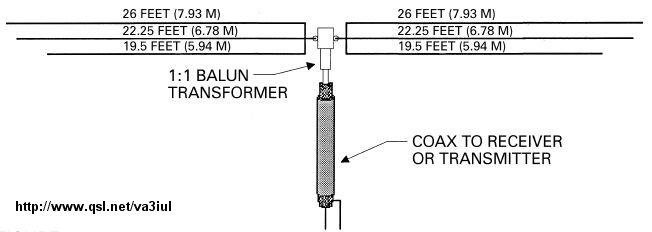
Inverted-Vee Antenna
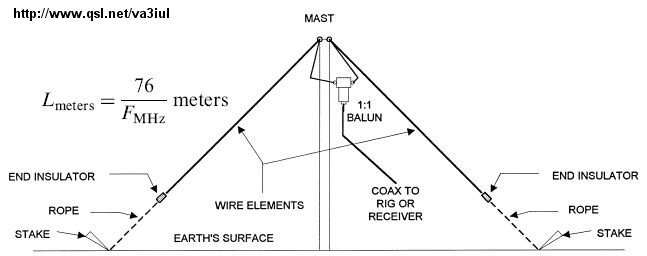
Sloping Dipole Antenna

Vertical Dipole

Delta Fed Dipole Antenna
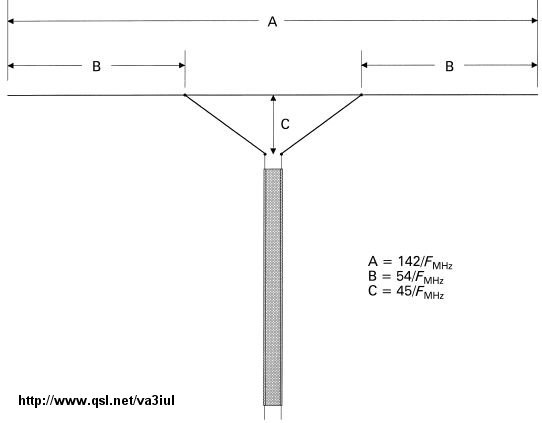
Bow-Tie Dipole Antenna

Bow-Tie Dipole Antenna

Multiband Tuned Doublet Antenna

G5RV Antenna

Wideband Dipole Antenna

Wideband Dipole for Receiving
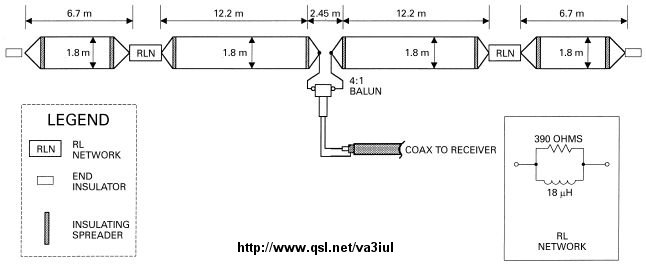
Tilted Folded Dipole Antenna

Right Angle Marconi Antenna

Linearly Loaded Tee Antenna
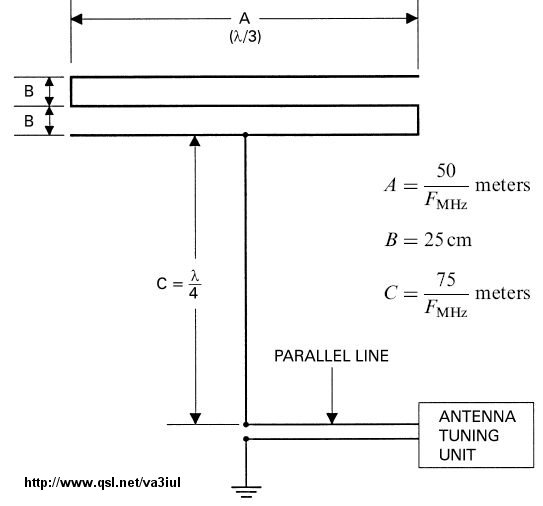
Reduced Size Dipole Antenna

Doublet Dipole Antenna

Delta Loop Antenna

Half Delta Loop Antenna

Collinear Franklin Antenna

Four Element Broadside Antenna

The Lazy-H Array Antenna
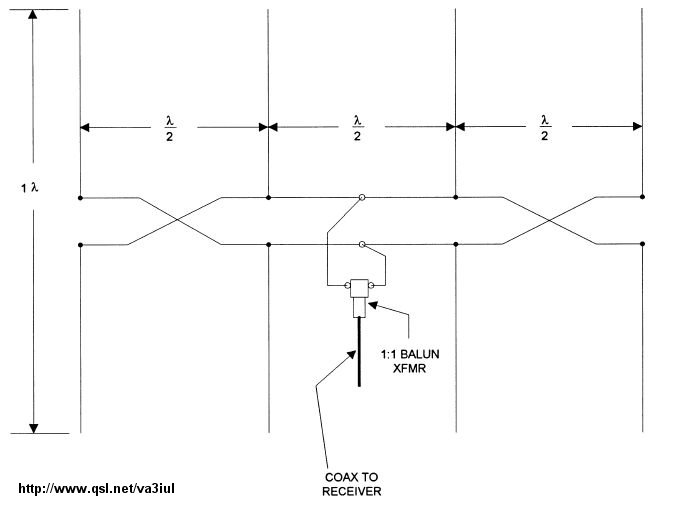
Sterba Curtain Array Antenna
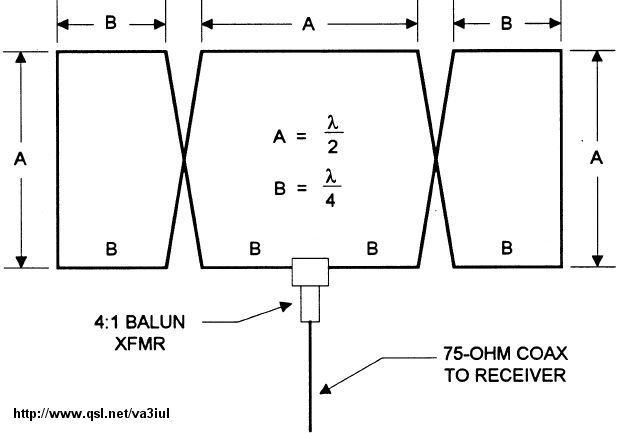
T-L DX Antenna

1.9 MHz Full-wave Loop Antenna

Multi-Band Portable Antenna

Terminated Sloper Antenna
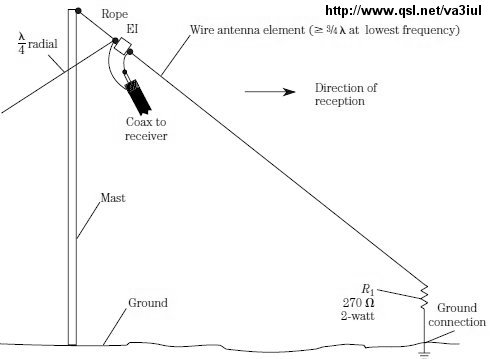
Double Extended Zepp Antenna

TCFTFD Dipole Antenna
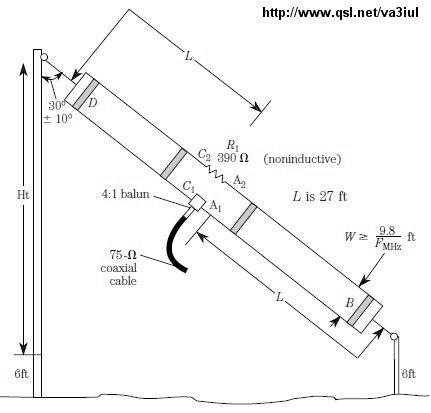
Vee-Sloper Antenna
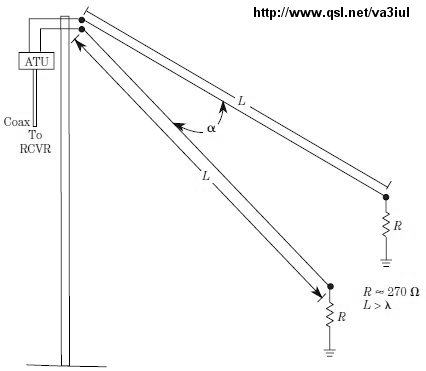
Rhombic Inverted-Vee Antenna

Counterpoise Longwire

Bisquare Loop Antenna
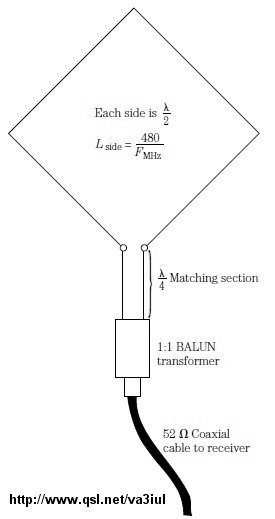
Piggyback Antenna for 10m

Vertical Sleeve Antenna for 10m

Double Windom Antenna

Double Windom for 9 Bands

Collinear Trap Antenna
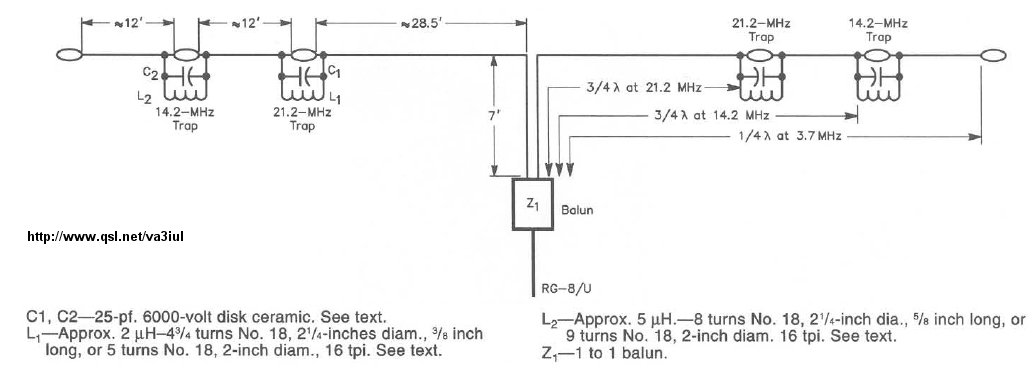
Short Dipole Antenna for 40m - 80m - 160m

Center Fed-Zepp Antenna for 80m - 40m

All-Bands Antenna

All-Bands Dipole Antenna

Multiband Z Antenna

Multiband Dipole Antenna

Five-Bands No-Tuner Antenna

Dualband Full-wave Loop Antenna for 80m-40m

Loop Antenna for 10m

Lazy Quad Antenna for 10m

Tri-band Delta Loop Antenna for 80m - 40m - 30m

Dual-band Loop Antenna for 30m - 40m

Wire-Beam Antenna for 80m
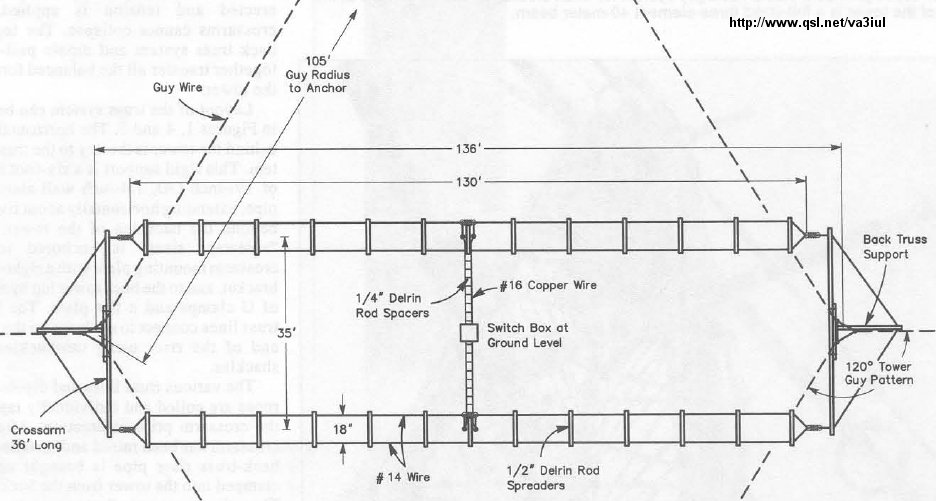
Dual-Band Sloper Antenna
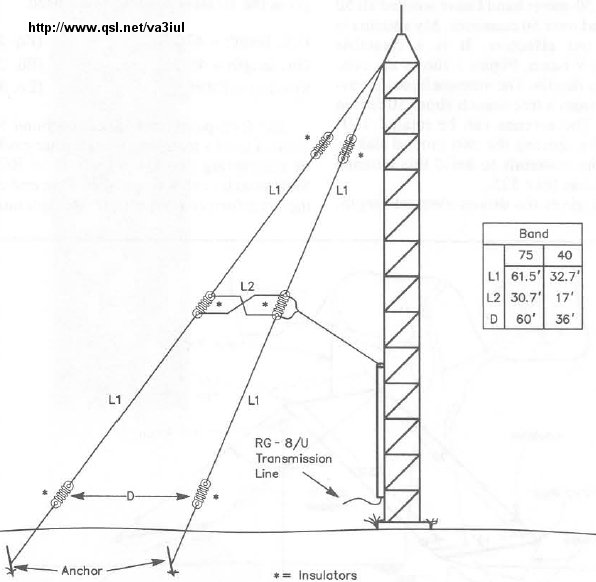
Inverted-V Beam Antenna for 30m

ZL-Special Beam Antenna for 15m
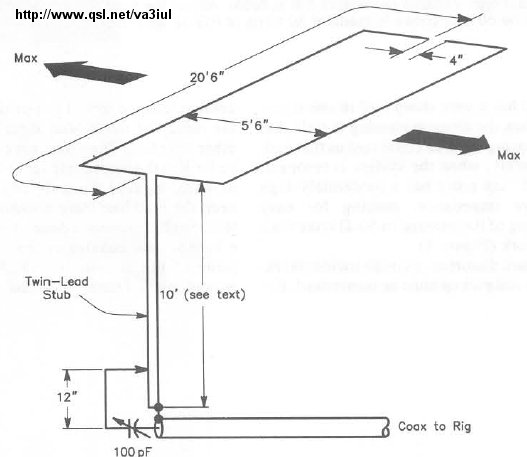
Half-Sloper Antenna for 160m

Two-Bands Half Sloper for 80m - 40m

Linear Loaded Sloper Antenna for 160m

Super-Sloper Antenna

Tower Pole as a Vertical Antenna for 80m

Clothesline Antenna

Wire Ground-Plane Antenna

Inverted Delta Loop for 160m

Inverted-L Antenna for 160m

Curtain Zepp Antenna for 160m, 80m, 40m

Curtain Zepp Antenna for 40m, 30m, 20m

Mini-Horse Yagi Antenna

Half-Rhombic Directive Antenna for 20m to 6m

Fan-Dipole Antenna for 80m through 6m

Read more...
Subscribe to:
Posts (Atom)



